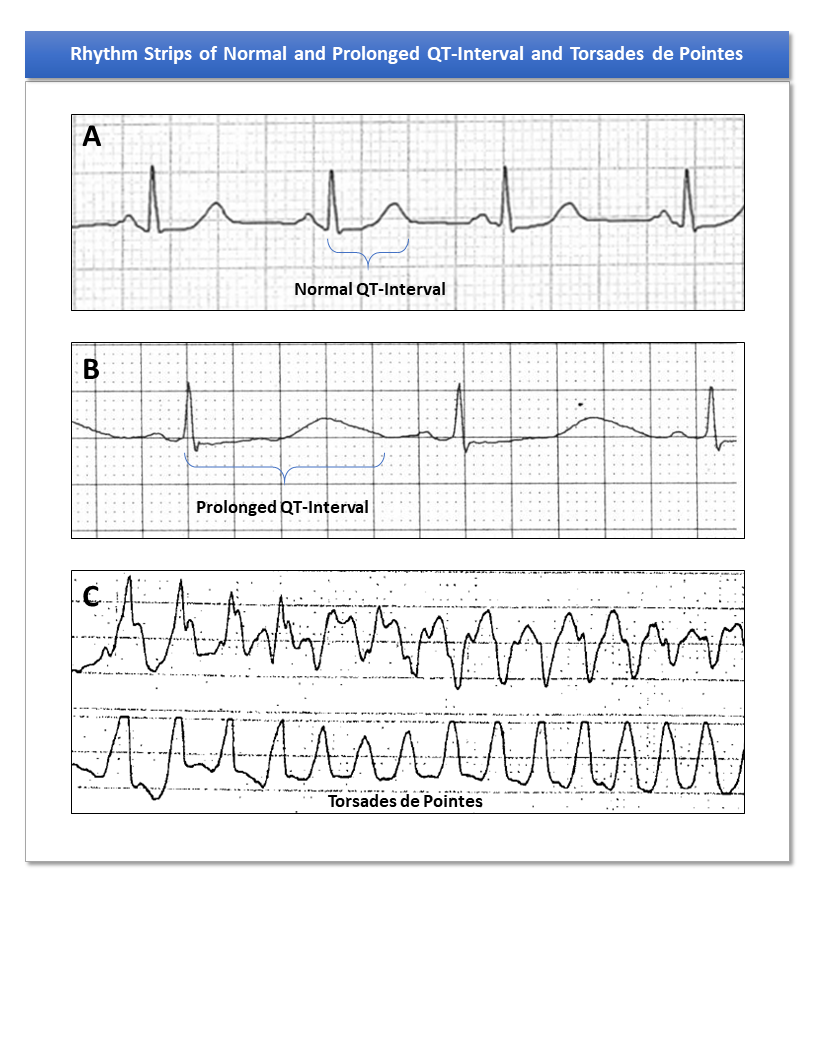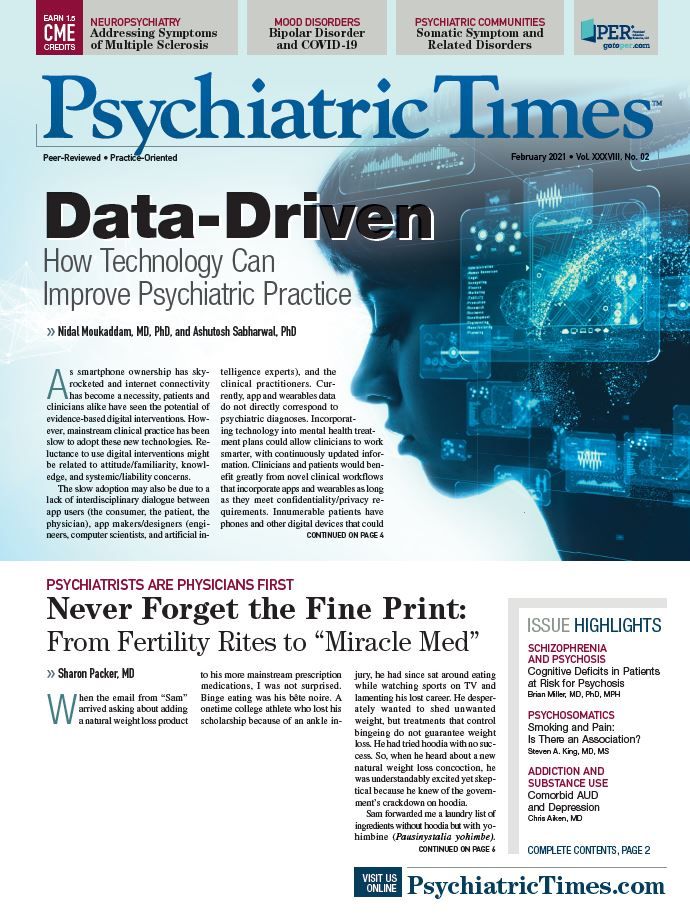SPECIAL REPORT: PSYCHOCARDIOLOGY
Psychiatrists prescribe medications that increase the risk of Torsades de Pointes (TdP), a potentially fatal polymorphic ventricular tachycardia that arises during abnormal ventricular repolarization. Prolongation of the corrected QT-interval (QTc) on the 12-lead electrocardiogram (Figure 1) (ECG) is a primary marker of TdP risk and a major drug safety benchmark used by the US Food and Drug Administration (FDA). Psychiatrists must be aware of risk factors that increase risk of TdP and feel comfortable performing individual risk-benefit analyses when prescribing a medication with known risk. This includes basic proficiency in ECG interpretation, including recognition and measurement of relevant intervals and application of appropriate corrections for heart rate (HR) and QRS duration.
Mechanism of Torsades de Pointes
Medications that prolong ventricular repolarization do so through direct blockade of the inward rectifier potassium channel (IKr) encoded by the human-ether-a-go-go related gene (hERG).1 This blockade results in slowed efflux of potassium from cardiac myocytes prolonging the duration of the cardiac action potential and the QT-interval on the ECG. TdP is typically triggered by early-after-depolarizations, ectopic activations of the ventricles arising during the prolonged repolarization phase.2
IN THIS SPECIAL REPORT
Exploring Integrated and Collaborative Care
Special Report Chair, Michelle Riba, MD, MS
Positivism and Heart Health: Issues for Psychiatrists
Christopher M. Celano, MD, and Jeff C. Huffman, MD
The ABCs of Cardiac Screening and Electrocardiography
Margo C. Funk, MD, MA, and Theodore A. Stern, MD
More online:
The Cardiovascular Consequences of Drug Use
Craig J. Beavers, PharmD, FACC, FAHA, FCCP, BCCP, BCPS-AQ Cardiology, CACP
Understanding the QTc
Margo C. Funk, MD, MA, and Junyang Lou, MD, PhD
Treatment Dilemmas in Depression and Coronary Heart Disease
Lawson Wulsin, MD, and Juliana Zambrano, MD
Most cases of TdP occur in the context of multiple risk factors, including use of more than 1 QTc prolonging medication, female sex, older age, bradycardia, personal history of structural or functional heart disease, personal or family history of sudden cardiac death (SCD), renal impairment (especially hemodialysis), hepatic impairment, and electrolyte disturbance (hypokalemia, hypomagnesemia, and hypocalcemia). Close attention should be given to co-administered medications that may inhibit metabolism of high-risk QTc prolonging medications.3
Cardiac Electrophysiology
The cardiac action potential begins with transmission of electrical activity from the sinoatrial (SA) node to the atrioventricular (AV) node, corresponding to the PR interval on the ECG. Electrical impulses then travel rapidly from the AV node through the His-Purkinje system, leading to rapid and synchronized ventricular depolarization, represented by the QRS complex. Repolarization of the ventricles occurs during the JT-interval, which begins at the J-point (end of the QRS complex) and ends with termination of the T-wave. Notably, the QT-interval includes the QRS complex and the JT-interval, encompassing both ventricular depolarization and repolarization.
Heart Rate Correction of the QT Interval
It is well recognized that the QT-interval is HR-dependent. Since the 1920s, the Bazett formula (QTc=QT/RR1/2) has been primarily used to derive the “heart rate-corrected QT interval,” or QTc, in clinical and research settings. Most computerized ECG interpretation software uses the Bazett formula by default. Unfortunately, the Bazett formula is well-known to overestimate the QTc during fast HR and underestimate it at lower HR. Recognizing this inadequacy, in 2017 the FDA transitioned from use of the Bazett formula to the Fridericia formula (QTc=QT/RR1/3) for drug monitoring studies.4 The American College of Cardiology (ACC), American Heart Association (AHA), and Heart Rhythm Society (HRS) recommend use of linear regression formulae such as Hodges, Framingham, or nomogram for HR-correction.5 A comprehensive study of more than 6000 participants comparing 5 heart rate correction formulae demonstrated most consistent QT correction (ie HR-independent) by Fridericia and Framingham.6 In general, the Fridericia, Hodges, and Framingham QTc formulae (Figure 2) have the most consistent data and are found in most online or app-based QTc calculators. Although the QTc is considered abnormal above 450 ms in men and 460 ms in women, TdP does not typically occur when the QTc is <500 ms. Most practitioners use 500 ms as an informal QTc cutoff.
Correction for Wide QRS from Bundle Branch Block or Ventricular Pacing
Ventricular conduction delay (VCD) from bundle branch block (BBB) or ventricular pacing manifests as widening of the QRS (QRS ≥ 110 ms) due to slowed, cell-to-cell depolarization of the myocardium rather than rapid conduction through the His-Purkinje system. Widening of the QRS complex artificially prolongs the QT-interval without prolonging repolarization.7 Psychiatrists who frequently treat patients with cardiac disease should be familiar with methods to correct the QT-interval for a wide QRS. Failure to correct for a wide QRS may result in inappropriate withholding or underdosing of necessary psychotropic medication. Recommendations by the ACC/AHA/HRS recommend use of a bivariate formula using both HR and QRS as variables, or the JTc (upper limits of normal: men=355 ms, women=372 ms).8
Medications
Many classes of medications, both psychotropics and commonly used non-psychotropics can prolong the QTc and increase the risk of TdP.3 One of the best online registries of QTc prolonging medications is www.crediblemeds.org. CredibleMeds® catalogues medications according to 4 main categories: Possible Risk (evidence for QTc prolongation), Conditional Risk (evidence for QTc prolongation under certain conditions such as overdose or when combined with another drug that inhibits metabolism of the primary drug), Known Risk (evidence for TdP), and Drugs to Avoid in Congenital Long QT. Though CredibleMeds® is a comprehensive registry, the levels of evidence are highly variable with many designations based only on case report. Psychiatrists must be familiar with the evidence for individual drugs to best inform a clinical decision. In the next sections we will highlight the key medications that all psychiatrists should know.
Methadone
Due to the rare nature of TdP, which can be silently lethal, it is difficult to study TdP as a primary outcome measure. Prolongation of the QTc serves as the closest proxy, however QTc prolongation is only a marker of risk and not an absolute predictor of TdP. Methadone is one of few medications implicated with TdP as an outcome and deserves vigilance.9 Guidelines for methadone safety and cardiac risk management have been developed by the Substance Abuse and Mental Health Services Administration (SAMHSA)10 and a joint effort of the American Pain Society and HRS.11 Neither set of guidelines recommend pretreatment ECG in the absence of other risk factors, however this issue has been controversial. Both guidelines balance vigilant monitoring for cardiac risk with attention to harm reduction strategies such that ECG screening does not become a barrier to methadone treatment. Methadone is not recommended in patients with a QTc ≥ 500 ms. For patients with a QTc ≥ 450 ms < 500 ms, alternatives like buprenorphine should be considered when possible. All modifiable risk factors for TdP should be evaluated and corrected prior to methadone initiation. There is not consensus on the frequency of follow-up ECGs, however this should depend on the baseline QTc (if performed), the presence of other risk factors, following dose changes or when total daily dose exceeds 120mg.10
Citalopram
In 2011, the FDA issued a drug safety communication stating that citalopram: should not be prescribed at doses > 40mg; should not be used at doses > 20mg in those with liver dysfunction or over age 60 years; and that 60mg dosing was no more efficacious than 40mg. This guidance was based on a single study which demonstrated an increased QTc of 8.5 ms at 20mg and 18.5ms at 60 ms. In 2012, the FDA downgraded their guidance, stating that citalopram was not recommended at doses > 40mg and should be discontinued in anyone with a QTc > 500 ms.
Since the FDA recommendations, multiple studies have demonstrated similar results, however studies examining risk of ventricular arrhythmia, sudden cardiac death, and all-cause mortality have shown no difference between citalopram and other SSRIs. Furthermore, patients on higher doses of citalopram that were reflexively reduced have increased risk of adverse psychiatric outcomes. Ultimately, the QTc prolongation risk with citalopram is statistically significantly higher than the other SSRIs, however the actual clinical risk is likely minimal.12 It is reasonable to obtain a pretreatment and steady-state ECG in patients prescribed citalopram who have other risk factors for TdP.
Intravenous Haloperidol
Intravenous (IV) haloperidol may be best known for its reputation to cause TdP; however, there is a paucity of data to support this impression. A systematic review of 77 clinical trials and case reports/series by Beach et al13 revealed that most prospective studies did not show a difference in QTc prolongation between IV haloperidol and placebo and no greater QTc prolongation than with other antipsychotics. Since IV haloperidol is used in the general hospital setting, often in the intensive care unit, most studies of IV haloperidol have unavoidable confounders, including severe medical illness (including electrolyte disturbance), older age, underlying cardiac disease, and concurrent use of multiple QTc prolonging medications. When using IV haloperidol is it reasonable to check a baseline ECG, consider daily ECG if other risk factors are present, mitigate as many modifiable risk factors as possible, and implement continuous monitoring or alternative agents if the QTc > 500 ms or cumulative dosage of IV haloperidol exceeds 100mg.13
Other Antipsychotics
Nearly all antipsychotics have been associated with QTc prolongation, however there is significant variability across the medication class. Of the typical antipsychotics, the low potency phenothiazines, including thioridazine and chlorpromazine, have been most consistently associated with QTc prolongation. Ziprasidone has the most QTc prolongation of the atypical antipsychotics. Of the other atypical antipsychotics, quetiapine has mild to moderate QTc prolongation with mixed data. Olanzapine, risperidone, and clozapine are considered to have mild prolongation of the QTc. Aripiprazole and lurasidone have the best cardiac safety profile of all antipsychotics.
There are no absolute recommendations for ECG monitoring when prescribing antipsychotics. Depending on the presence of other TdP risk factors and the specific risk associated with the individual antipsychotic, psychiatrists may consider obtaining a baseline and steady-state ECG with vigilance for QTc > 500 ms or a QTc increase of ≥ 60 ms following medication initiation.
Other Antidepressants and Mood Stabilizers
In healthy patients with no underlying heart disease, tricyclic antidepressants (TCA) administered at therapeutic doses likely have little impact on the QTc with low risk of TdP; however, in cases of overdose or when used in patients with underlying cardiac disease, especially ventricular conduction delay or ischemic heart disease, TdP can occur.14 Of the other antidepressants, including SSRIs and serotonin-norepinephrine reuptake inhibitors (SNRIs), citalopram carries the most risk of QTc prolongation. Sertraline is the best studied and has the best cardiac safety profile for patients with heart disease. Antiepileptic medications used for mood stabilization have not been shown to prolong the QTc. The few studies of lithium have not demonstrated clinically significant QTc prolongation when serum levels are within the therapeutic range.15 Supratherapeutic lithium levels are associated with modest increases of QTc.16
Non-Psychotropic Medications
Some of the most common non-psychotropic medications have significant QTc prolongation and deserve special attention. These include the macrolide antibiotics (eg, azithromycin), antifungals (eg, fluconazole), most antiemetics (eg, ondansetron), furosemide (mediated by fluctuation of potassium) and antiarrhythmics (eg, amiodarone).3 Many of these medications are known cytochrome p450 inhibitors of other QTc prolonging medications and require vigilance, with consideration for alternatives, when used in combination.17
Conclusions
When prescribing medications with known risk of QTc prolongation or TdP, psychiatrists must perform a comprehensive risk-benefit analysis with consideration of the QTc, risk factors for TdP, strategies to mitigate cardiac risks when possible, and psychiatric adverse outcomes from not prescribing a medication.
Dr Funk is the program director of the Harvard South Shore (HSS) psychiatry residency training program. Dr Lou is an interventional cardiologist at Brigham and Women’s Hospital.
References
1. Sanguinetti MC, Tristani-Firouzi M. hERG potassium channels and cardiac arrhythmia. Nature. 2006;440(7083):463-9.
2. Lankipalli RS, Zhu T, Guo D, Yan GX. Mechanisms underlying arrhythmogenesis in long QT syndrome. J Electrocardiol. 2005;38(4 Suppl):69-73.
3. Funk MC, Beach SR, Bostwick JR, Celano CM, et al. QTc prolongation and psychotropic medications. Am J Psych. 2020;177(3):273-274.
4. US Food and Drug Administration. E14 Clinical evaluation of QT/QTc interval prolongation and proarrhythmic potential for non-antiarrhythmic drugs—questions and answers (R3) guidance for industry. June 2017. https://www.fda.gov/regulatory-information/search-fda-guidance-documents/e14-clinical-evaluation-qtqtc-interval-prolongation-and-proarrhythmic-potential-non-antiarrhythmic-1
5. Rautaharju PM, Surawicz B, Gettes LS, et al. AHA/ACCF/HRS recommendations for the standardization and interpretation of the electrocardiogram: part IV: the ST segment, T and U waves, and the QT interval: a scientific statement from the American Heart Association Electrocardiography and Arrhythmias Committee, Council on Clinical Cardiology; the American College of Cardiology Foundation; and the Heart Rhythm Society: endorsed by the International Society for Computerized Electrocardiology. Circulation. 2009;119(10):e241–e250.
6. Vandenberk B, Vandael E, Robyns T, et al. Which QT correction formulae to use for QT monitoring? J Am Heart Assoc.2016;5(6):e003264.
7. Das G. QT interval and repolarization time in patients with intraventricular conduction delay. J Electrocardiol. 1990;23(1):49-52.
8. Yankelson L, Hochstadt A, Sadeh B, et al. New formula for defining “normal” and “prolonged” QT in patients with bundle branch block. J Electrocardiol. 2018;51(3):481-486.
9. Romero J, Baldinger SH, Goodman-Meza D, Engstrom K, et al. Drug-induced torsades de pointes in an underserved urban population. Methadone: is there therapeutic equipoise? J Interv Card Electrophysiol. 2016;45(1):37-45.
10. Martin JA, Campbell A, Killip T, Kotz M, et al. QT interval screening in methadone maintenance treatment: report of a SAMHSA expert panel. J Addict Dis. 2011;30(4):283-306.
11. Chou R, Cruciani RA, Fiellin DA, Compton P, et al. Methadone safety: a clinical practice guideline from the American Pain Society and College of Problems of Drug Dependence, in collaboration with the Heart Rhythm Society. J Pain. 2014;15(4):321-37.
12. Beach SR, Celano CM, Sugrue AM, et al. QT prolongation, torsades de pointes, and psychotropic medications: A 5-year update. Psychosomatics. 2018;59(2):105-122.
13. Beach SR, Gross AF, Hartney KE, Taylor JB, et al. Intravenous haloperidol: A systematic review of side effects and recommendations for clinical use. Gen Hosp Psychiatry. 2020;67:42-50.
14. Glassman AH. Cardiovascular effects of antidepressant drugs: updated. J Clin Psychiatry. 1998;59(Suppl 150):13-18.
15. Reilly JG, Ayis SA, Ferrier IN, Jones SJ, et al. QTc-interval abnormalities and psychotropic drug therapy in psychiatric patients. Lancet. 2000;355(9209):1048-1052.
16. Hsu CH, Liu PY, Chen JH, Yeh TL, et al. Electrocardiographic abnormalities as predictors for over-range lithium levels. Cardiology. 2005;103(2):101-106.
17. Indiana University Department of Medicine. Drug Interactions Flockhart Table™. https://drug-interactions.medicine.iu.edu/MainTable.aspx










